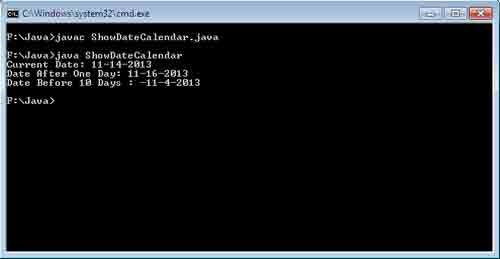In this Example, Calendar class is an abstract class present in java.util package. getInstance method is a static method of Calendar class. This method is used to create the object of Calendar class. Return type of this method is Calendar class object. Syntax-public static Calendar getInstance (). get method is a predefined method of Calendar class. It is used to return the value of a given calendar field. Return type of this method is int type. Syntax-public int get (int)
MONTH, YEAR, DATE are predefined constants of Calendar class. Syntax-public static final int MONTH, public static final int YEAR, public static final int DATE add method is a predefined abstract method of Calendar class. It adds or substracts the specified amount of time to the given calendar field. Here we subtract 10 days from the current date. Syntax-public abstract void add (int field, int amount)
Here is the Java Example for Calendar Class
import java.util.Calendar;
public class ShowDateCalendar
{
public static void main(String[] args)
{
Calendar now=Calendar.getInstance();
System.out.println("Current Date: " +(now.get (Calendar.MONTH)) + "-" + now.get(Calendar.DATE) + "-"+ now.get (Calendar.YEAR));
now.add(Calendar.DATE,1);
System.out.println ("Date After One Day: "+ (now.get (Calendar.MONTH)) +"-"+ (now.get (Calendar.DATE) +1) +"-"+ now.get (Calendar.YEAR));
now=Calendar.getInstance();
now.add(Calendar.DATE,-10);
System.out.println ("Date Before 10 Days : " +"-" +(now.get(Calendar.MONTH)) +"-" + (now.get(Calendar.DATE)) + "-" + now.get(Calendar.YEAR));
}
}

 Dinesh Thakur holds an B.C.A, MCDBA, MCSD certifications. Dinesh authors the hugely popular
Dinesh Thakur holds an B.C.A, MCDBA, MCSD certifications. Dinesh authors the hugely popular